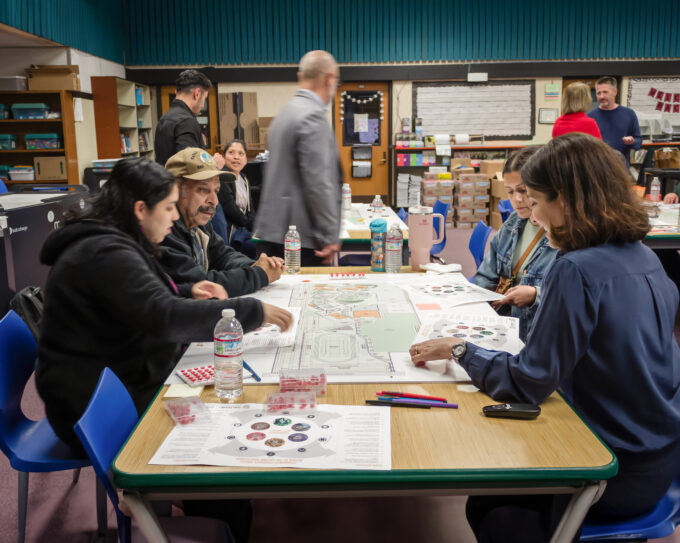California students and their families are navigating many issues – housing and food insecurity, immigration needs, and income inequality – and schools today are more than just spaces for learning; they are a vital community resource. With such a diversity of experiences and thoughts, it is important that we, as designers, listen to the voices of everyone in the community. Reaching out to the community is key to designing welcoming and inclusive schools. Everyone has a voice, and here at HMC, we’re committed to continually enhancing our listening practices. Recently, we conducted unique multilingual community workshops to connect with two northern California communities, San Benito High School District’s (SBHSD) Hollister High School in Hollister, California, and Sacramento City Unified School District’s Nicholas Elementary School in Sacramento, California.
Hollister High School #2
Forty miles south of California’s Silicon Valley, SBHSD serves over 3,000 students. HMC has been asked to assist in the programming, planning, and design of the district’s second high school. The new school aims to relieve overcrowding at the existing high school, which is the tenth-largest school by population in the state.
Nearly five hundred Hollister High School students are members of migrant and seasonal farm-working families supported by California’s Migrant Education Program (MEP). The MEP is a federal program that provides supplementary educational and support services to migrant children whose families move frequently across school districts or states for agricultural work. The program aims to help reduce educational disruptions and other challenges. Hollister High School’s students regularly travel from their homes in the district to farms throughout California and Arizona to help harvest the food that feeds us, and many students and their families speak Spanish as their primary language.
To engage the community in the design of the new school, SBHSD hosted a series of town halls as we began the design process. One was conducted in English and the other entirely in Spanish, which allowed for more active participation, engagement, and seamless sharing of everyone’s insights into the community’s desires and needs. More than 100 people attended the Spanish language event, where we discussed potential campus configurations. A presentation was given in Spanish, followed by group activities facilitated by one of our HMC team members and a translator at each table. Activities included 3D building block puzzles and blank slate brainstorming.
The district’s Migrant Education Program Specialist, Liliana Ruiz, invited families from her program to participate. Families appreciated that their voices and opinions were valued and were happy to have a say in the design of the new high school. For the parents who don’t typically speak up in larger settings, small group discussions allowed them a space to participate and their opinions provided the design team with invaluable insights and input.
The district received over 1,300 comments about the new high school through the bilingual engagement process. This will help the design team tailor our designs to meet the community’s needs effectively while reflecting their broader aspirations. As designers, we must hold ourselves accountable and be transparent with how community feedback is integrated into the design process. So, to ensure responsiveness to their feedback, a series of design strategies were established, and we used simple graphics to illustrate the framework clearly. This served as both a guide for the design process and allowed us to visually and tangibly connect the design decisions with the community’s input and the district’s core goals. This unique approach reflects a diverse range of ideas and perspectives and creates a roadmap for all our design decisions so that the resulting master plan not only meets the functional requirements of the school but also embodies the community’s vision.
The language of architecture and school design is universal. Hosting a Spanish-language event allowed us to listen and learn, and I’m certain the outcomes will be better for it. – Brian Meyers, PreK-12 Practice Leader

Nicholas Elementary
Sacramento City Unified School District’s Nicholas Elementary School in Sacramento, California, will deliver a long-overdue resource to the students of this historically disadvantaged community. As one of the largest school districts in California, SCUSD has made equity a critical lens through which they are assigning the $750 million from their 2020 Measure H bond. Designing Nicholas as a “Community School” has been one of the overarching goals of this project, which is to create a hub for the families of this south Sacramento neighborhood. Beyond designing spaces for learning, the school will also feature a 1,200-1,600 SF space dedicated to the community, providing medical, dental, and legal services.
Nicholas Elementary School students speak various languages, including Spanish, Vietnamese, Hmong, Farsi, Urdu, and Mandarin. We led another multilingual community forum to reach these students and their families. While the presentation was in English, interpreters utilized real-time interpretation headsets, ensuring everyone could understand and participate in the conversation.
At the community meeting, young students and their parents asked good questions of the design team and district officials. Community members voted on exterior color schemes for the campus and playground equipment options. A showstopper moment was when a second-grade girl delivered an especially posed set of remarks to the gathering.
Schools are community hubs, so getting their support for their new school communities is essential. It is paramount to include the community as much as possible to understand the district’s, students’, and teachers’ vision for the school. As a majority-minority company, HMC believes you cannot design for the human experience if you cannot be human. We celebrate the diversity that makes our firm great and work to use our diversity to better engage with our communities like we have in San Benito County and South Sacramento.

